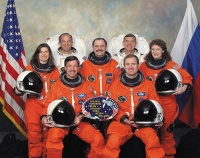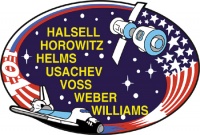STS-101
From The Space Library
 | |
| Organization | NASA-Office of Space Flight (United States) |
|---|---|
| Mission type | Human Crew |
| Launch date | May 19, 2000 |
| Launch vehicle | Space Shuttle |
| Launch site | Cape Canaveral, United States |
| COSPAR ID | 2000-027A |
| Inclination | 51.6 degrees |
| Experiments | Here |
| Alternate Names | 26368 |
| Additional Information | Here |
| Data Collection | Here |
| Payload Mass Up | 11218.7 kg |
| Payload Mass Down | 10488.18 kg |
| Orbiter | Atlantis |
| Lift Off Mass | 2,054,384.09 kg |
| Orbiter Weight at Liftoff | 119,330.91 kg |
| Orbiter Weight at Landing | 100,577.73 kg |
| Landed | Concrete runway 15 at Kennedy Space Center, Fla. |
| Orbits of Earth | 156 |
| Orbital Altitude | 173 nautical miles (259 statute miles) |
Contents |
[edit] Crew
- Commander: James D. Halsell
- Pilot: Scott J. Horowitz
- Payload Commander:
- Mission Specialist 1: Mary Ellen Weber
- Mission Specialist 2: Jeffrey N. Williams
- Mission Specialist 3: James S. Voss
- Mission Specialist 4: Susan J. Helms
- Mission Specialist 5: Yuri V. Usachev
- Payload Specialist 1:
- Payload Specialist 2:
ISS/Mir Crew Transport
[edit] Mission
STS 101 was an American shuttle craft that was launched from Cape Canaveral at 10:11 UT. The main mission was to carry out repairs and upgrades to the International Space Station (ISS): to replace four of the six solar charged batteries on the Zarya module, to stabilize a wobbly 3-meter construction crane that was installed during an earlier shuttle mission, to complete the installation of a partially installed Russian 15-meter crane on the Zarya module, to replace a faulty communications antenna, to boost by 32 km the altitude of the station which has been loosing 2.4 km/week, to deliver a ton of food, fuel and supplies to the station, and prepare the station for the arrival of the Russian service module, Zvezda, in mid-July. All objectives were implemented and STS 101 landed back in Cape Canaveral at 06:20 UT on 29 May.
[edit] EVA
Extravehicular Activity (EVA) conducted by James Voss and Jeffrey Williams, 6 hours, 44 minutes. During the EVA, Voss and Williams made the last planned equipment changes prior to the arrival of the ISS's third element, Russia's service module Zvezda. They completed assembly of a Russian crane, tested the integrity of a U.S. crane, replaced a faulty communications antenna, installed handrails, and set up a camera cable.
[edit] Payload
BioTube precursor experiment; SPACEHAB; integrated cargo carrier; mission to America's remarkable schools; space experiment module 6; HTD 1403 micro wireless instrumentation system HEDS technology demonstration
[edit] Books about the Space Shuttle Program
Buy This Book Click here |
Buy This Book here |
Buy This Book Click here |
Buy This Book Click here |





